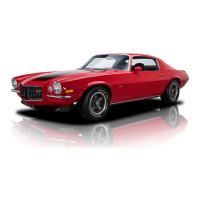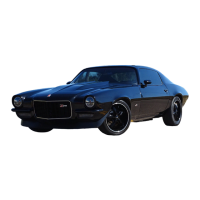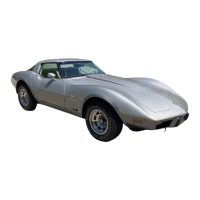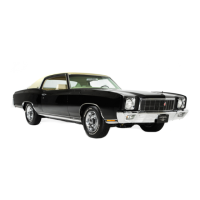Do you have a question about the Chevrolet 1970 and is the answer not in the manual?
Describes operation and maintenance of air pollution control systems on the car.
Information on seeking assistance from the Chevrolet Dealer and zone offices.
Recommendations to help maintain safety and dependability of the Chevrolet.
Advice on ensuring adequate protection for the Chevrolet investment through proper service.
Guidelines for safe driving in traffic and precautions when parked.
Recommendations for driving safely at night, including sunglasses and headlights.
Cautions and advice for driving safely in inclement weather and bad roads.
Specific recommendations for driving cautiously and safely during winter conditions.
Tips for preparing for extended trips and general driving advice.
Recommendations for driving during the initial few hundred miles for optimal performance.
Information on using the new Chevrolet for trailer hauling.
Warnings about exhaust gases and precautions for prolonged engine idling.
Importance of maintaining the exhaust system for economy and safety.
Description of the anti-theft steering column lock and its positions.
Precautions for parking and securing the vehicle when unattended.
Step-by-step procedures and safety precautions for starting the engine.
Recommendations for engine warm-up and starting in cold weather.
Explanation of the 3-speed manual transmission shift positions and operation.
Advice on descending grades and shifting on slippery surfaces.
Overview of Powerglide, Turbo Hydra-Matic transmissions and their operation.
Explanation of shift indicator sequences and starter safety switch.
Description of column shift lever operation and movement.
Details the positions and usage of the Powerglide shift quadrant.
Details the positions and usage of the Turbo Hydra-Matic shift quadrant.
Tips for descending grades, holding on upgrades, and rocking the car.
Recommendations for parking safely and towing with the ignition key.
Special provisions for towing a vehicle without the ignition key.
Detailed instructions and cautions for using jumper cables and battery hazards.
Overview of instrument cluster gauges and the fuel gauge operation.
Explanation of various indicator lights on the instrument panel.
Overview of various controls located on the instrument panel.
Operation of light switches and hazard warning flashers.
Operation and use of the four-way hazard warning flasher system.
Description of the optional headlamp washer system and its operation.
Operation of headlight beam switch and optional light watch system.
Operation of turn signals, lane change feature, and indicator lights.
Function of the service brake system and its warning light.
Explanation of power brakes and self-adjusting brake mechanisms.
Cautions regarding brake pedal obstruction and riding the brake.
Operation of the parking brake and clutch adjustment.
Operation of the two-speed electric windshield wiper and washer system.
Washer fluid monitoring and description of vehicle keys.
How to lock and unlock doors and security precautions.
How to operate heater controls for air flow and temperature.
Tips for heater operation and advice for snow driving.
How to operate the GM Chevrolet Air Conditioning System using knobs and vanes.
Note about potential reduced cooling at highway speeds with city setting.
How temperature and selector levers control heating and cooling functions.
Description of fan speeds and selector lever positions for climate control.
Explanation of different A/C modes like Bi-Level, VENT, HEATER, DE-FOG.
Description of DE-ICE mode and a tip for snow driving visibility.
Overview of Comfortron system and its control panel.
How to operate the temperature dial and control lever for automatic climate control.
How to control air outlets and tips for operating the A/C system.
Caution for operating system 30 seconds before DE-ICE for fogging.
How to operate radios, including Push Button AM and AM/FM features.
Information on the antenna and Stereo Multiplex Adapter.
How to tune stereo radios and operate the optional tape system.
Recommendations for cleaning and caring for the tape player.
Features of folding seat backs and their manual/electric release.
Description and operation of the six-way electrically operated front seats.
Caution against using the filler panel between rear seat and window for storage.
How to use Cruise-Master and important operational cautions.
Operation of the optional speed warning indicator and its buzzer.
Operation of tilt steering wheel and benefits of Positraction rear axle.
Importance and use of lap and shoulder belts for passenger safety.
Proper usage and features of lap belts and automatic retractors.
Benefits of shoulder belts and cautions regarding their use.
Guidelines for inspecting and caring for seat belts and their components.
Technique for pre-positioning the body for frontal impact reduction.
How to operate and inspect head restraints for proper function.
Information on GM infant safety carriers and child safety seats.
How to use child restraints with lap belts, including proper storage of unused belts.
Precautions for transporting children in vehicles without special restraints.
Proper use of rearview mirrors and operation of air vents.
Operation of clock, ash tray, and power steering system.
Operation of power windows and door locks for convenience and security.
Information on fuel tank system, hood release, and gas cap.
How to open the trunk and location of spare tire and jack.
Steps for operating the convertible top, including temperature cautions.
Instructions for installing the top boot and caring for the top material.
How Superlift shocks allow load space adjustment with air and automatic level control.
Information on the acrylic lacquer finish and best practices for washing.
Advice on polishing, waxing, and cleaning exterior bright metal parts.
How to clean white sidewall tires and the optional vinyl top.
Recommendations for cleaning interior surfaces and cautions on solvents.
Emphasizes regular maintenance for preserving car value and safety.
Highlights crucial maintenance for engine oil and safety-related components.
How the service program ensures quality and the Dealer's role.
List of items to periodically check for proper operation and safety.
Schedule detailing services to be performed at specific intervals.
Specific services recommended at 12,000 and 24,000-mile intervals.
Recommended fuel grades and advice for operating in foreign countries.
Specification for engine oil and guide to selecting proper viscosity.
How to properly check and maintain the engine oil level.
How to check coolant level and procedures for system servicing.
Function of thermostat, radiator cap, and system draining procedures.
Importance of tire wear, alignment, and balancing for safety and longevity.
Importance of checking brake linings and components for safe operation.
Table showing standard and optional tire sizes for different models.
Finding recommended pressures and consequences of improper inflation.
Recommends tire rotation, jack operation, and raising the car safely.
Step-by-step instructions for safely changing a tire.
Guidelines for engine oil changes, tune-ups, and emission system checks.
Importance of PCV valve and Evaporation Control System servicing.
Maintenance for oil filter, heat control valve, and drive belts.
Fuel filter replacement, axle lubrication, and manual transmission service.
Recommendations for automatic transmission fluid and change intervals.
Procedures for checking and changing automatic transmission fluid.
Powerglide band adjustment and linkage lubrication.
Lubrication of suspension, steering, and wheel bearings.
Importance of brake checks, fluid levels, and master cylinder.
Standard steering gear and parking brake cable maintenance.
Checking power steering fluid and maintaining hood latches.
A/C system checks and battery maintenance procedures.
Advice on preparing the Chevrolet for extended storage.
Factors affecting durability and importance of proper trailer hauling equipment.
Maintaining tongue load and speed recommendations when towing trailers.
A chart guiding users to check specific paragraphs for possible causes of malfunctions.
How to check fuel flow, filter, and carburetor for starting problems.
Checks for faulty idle, choke, or dirty air cleaner element.
Procedures for diagnosing electrical issues when the engine won't start.
How to check starter, battery, and spark for ignition problems.
Checks for overheating issues, including oil and coolant levels.
How to clean radiator core, check fan belt, and understand thermostat function.
Location of VIN and vehicle dimensions.
Capacities for fuel tank, crankcase, and cooling system specifications.
Specifications for A/C, battery, tires, and turn signal flasher.
Engine data including horsepower, torque, and recommended spark plugs.
How fuses and circuit breakers protect the vehicle's wiring circuits.
Location and function of fuses, breakers, and bulb specifications.
Recommendations for engine oil, air cleaner, and fuel filters.
Recommendations for PCV valve and Evaporation Control System filter.
Importance of tire wear, alignment, and balancing for safety and longevity.
Importance of checking brake linings and components for safe operation.
Checking parking brake, brake fluid, and lines for proper function.
Inspection of exhaust system and periodic check of all vehicle lights.
Checking headlamp aim and power steering system for proper function.
Overview of other safety features like anti-theft lock and seat belts.
Checking defroster, starter switch, and transmission indicators.
Checking latches, locks, and inspecting for fluid leaks.
Explanation of combustion process and emissions in automotive engines.
Importance of regular engine servicing for efficiency and minimizing emissions.
How the PCV system prevents crankcase emissions from entering the ambient air.
How CCS reduces exhaust pollution by altering the combustion process.
How the AIR system reduces air pollution by oxidizing exhaust gases.
How TCS reduces exhaust emissions by controlling spark advance.
System designed to minimize fuel vapor escape requiring periodic servicing.
Schedule for periodic service to improve air quality and engine performance.
Describes operation and maintenance of air pollution control systems on the car.
Information on seeking assistance from the Chevrolet Dealer and zone offices.
Recommendations to help maintain safety and dependability of the Chevrolet.
Advice on ensuring adequate protection for the Chevrolet investment through proper service.
Guidelines for safe driving in traffic and precautions when parked.
Recommendations for driving safely at night, including sunglasses and headlights.
Cautions and advice for driving safely in inclement weather and bad roads.
Specific recommendations for driving cautiously and safely during winter conditions.
Tips for preparing for extended trips and general driving advice.
Recommendations for driving during the initial few hundred miles for optimal performance.
Information on using the new Chevrolet for trailer hauling.
Warnings about exhaust gases and precautions for prolonged engine idling.
Importance of maintaining the exhaust system for economy and safety.
Description of the anti-theft steering column lock and its positions.
Precautions for parking and securing the vehicle when unattended.
Step-by-step procedures and safety precautions for starting the engine.
Recommendations for engine warm-up and starting in cold weather.
Explanation of the 3-speed manual transmission shift positions and operation.
Advice on descending grades and shifting on slippery surfaces.
Overview of Powerglide, Turbo Hydra-Matic transmissions and their operation.
Explanation of shift indicator sequences and starter safety switch.
Description of column shift lever operation and movement.
Details the positions and usage of the Powerglide shift quadrant.
Details the positions and usage of the Turbo Hydra-Matic shift quadrant.
Tips for descending grades, holding on upgrades, and rocking the car.
Recommendations for parking safely and towing with the ignition key.
Special provisions for towing a vehicle without the ignition key.
Detailed instructions and cautions for using jumper cables and battery hazards.
Overview of instrument cluster gauges and the fuel gauge operation.
Explanation of various indicator lights on the instrument panel.
Overview of various controls located on the instrument panel.
Operation of light switches and hazard warning flashers.
Operation and use of the four-way hazard warning flasher system.
Description of the optional headlamp washer system and its operation.
Operation of headlight beam switch and optional light watch system.
Operation of turn signals, lane change feature, and indicator lights.
Function of the service brake system and its warning light.
Explanation of power brakes and self-adjusting brake mechanisms.
Cautions regarding brake pedal obstruction and riding the brake.
Operation of the parking brake and clutch adjustment.
Operation of the two-speed electric windshield wiper and washer system.
Washer fluid monitoring and description of vehicle keys.
How to lock and unlock doors and security precautions.
How to operate heater controls for air flow and temperature.
Tips for heater operation and advice for snow driving.
How to operate the GM Chevrolet Air Conditioning System using knobs and vanes.
Note about potential reduced cooling at highway speeds with city setting.
How temperature and selector levers control heating and cooling functions.
Description of fan speeds and selector lever positions for climate control.
Explanation of different A/C modes like Bi-Level, VENT, HEATER, DE-FOG.
Description of DE-ICE mode and a tip for snow driving visibility.
Overview of Comfortron system and its control panel.
How to operate the temperature dial and control lever for automatic climate control.
How to control air outlets and tips for operating the A/C system.
Caution for operating system 30 seconds before DE-ICE for fogging.
How to operate radios, including Push Button AM and AM/FM features.
Information on the antenna and Stereo Multiplex Adapter.
How to tune stereo radios and operate the optional tape system.
Recommendations for cleaning and caring for the tape player.
Features of folding seat backs and their manual/electric release.
Description and operation of the six-way electrically operated front seats.
Caution against using the filler panel between rear seat and window for storage.
How to use Cruise-Master and important operational cautions.
Operation of the optional speed warning indicator and its buzzer.
Operation of tilt steering wheel and benefits of Positraction rear axle.
Importance and use of lap and shoulder belts for passenger safety.
Proper usage and features of lap belts and automatic retractors.
Benefits of shoulder belts and cautions regarding their use.
Guidelines for inspecting and caring for seat belts and their components.
Technique for pre-positioning the body for frontal impact reduction.
How to operate and inspect head restraints for proper function.
Information on GM infant safety carriers and child safety seats.
How to use child restraints with lap belts, including proper storage of unused belts.
Precautions for transporting children in vehicles without special restraints.
Proper use of rearview mirrors and operation of air vents.
Operation of clock, ash tray, and power steering system.
Operation of power windows and door locks for convenience and security.
Information on fuel tank system, hood release, and gas cap.
How to open the trunk and location of spare tire and jack.
Steps for operating the convertible top, including temperature cautions.
Instructions for installing the top boot and caring for the top material.
How Superlift shocks allow load space adjustment with air and automatic level control.
Information on the acrylic lacquer finish and best practices for washing.
Advice on polishing, waxing, and cleaning exterior bright metal parts.
How to clean white sidewall tires and the optional vinyl top.
Recommendations for cleaning interior surfaces and cautions on solvents.
Emphasizes regular maintenance for preserving car value and safety.
Highlights crucial maintenance for engine oil and safety-related components.
How the service program ensures quality and the Dealer's role.
List of items to periodically check for proper operation and safety.
Schedule detailing services to be performed at specific intervals.
Specific services recommended at 12,000 and 24,000-mile intervals.
Recommended fuel grades and advice for operating in foreign countries.
Specification for engine oil and guide to selecting proper viscosity.
How to properly check and maintain the engine oil level.
How to check coolant level and procedures for system servicing.
Function of thermostat, radiator cap, and system draining procedures.
Importance of tire wear, alignment, and balancing for safety and longevity.
Importance of checking brake linings and components for safe operation.
Table showing standard and optional tire sizes for different models.
Finding recommended pressures and consequences of improper inflation.
Recommends tire rotation, jack operation, and raising the car safely.
Step-by-step instructions for safely changing a tire.
Guidelines for engine oil changes, tune-ups, and emission system checks.
Importance of PCV valve and Evaporation Control System servicing.
Maintenance for oil filter, heat control valve, and drive belts.
Fuel filter replacement, axle lubrication, and manual transmission service.
Recommendations for automatic transmission fluid and change intervals.
Procedures for checking and changing automatic transmission fluid.
Powerglide band adjustment and linkage lubrication.
Lubrication of suspension, steering, and wheel bearings.
Importance of brake checks, fluid levels, and master cylinder.
Standard steering gear and parking brake cable maintenance.
Checking power steering fluid and maintaining hood latches.
A/C system checks and battery maintenance procedures.
Advice on preparing the Chevrolet for extended storage.
Factors affecting durability and importance of proper trailer hauling equipment.
Maintaining tongue load and speed recommendations when towing trailers.
A chart guiding users to check specific paragraphs for possible causes of malfunctions.
How to check fuel flow, filter, and carburetor for starting problems.
Checks for faulty idle, choke, or dirty air cleaner element.
Procedures for diagnosing electrical issues when the engine won't start.
How to check starter, battery, and spark for ignition problems.
Checks for overheating issues, including oil and coolant levels.
How to clean radiator core, check fan belt, and understand thermostat function.
Location of VIN and vehicle dimensions.
Capacities for fuel tank, crankcase, and cooling system specifications.
Specifications for A/C, battery, tires, and turn signal flasher.
Engine data including horsepower, torque, and recommended spark plugs.
How fuses and circuit breakers protect the vehicle's wiring circuits.
Location and function of fuses, breakers, and bulb specifications.
Recommendations for engine oil, air cleaner, and fuel filters.
Recommendations for PCV valve and Evaporation Control System filter.
Importance of tire wear, alignment, and balancing for safety and longevity.
Importance of checking brake linings and components for safe operation.
Checking parking brake, brake fluid, and lines for proper function.
Inspection of exhaust system and periodic check of all vehicle lights.
Checking headlamp aim and power steering system for proper function.
Overview of other safety features like anti-theft lock and seat belts.
Checking defroster, starter switch, and transmission indicators.
Checking latches, locks, and inspecting for fluid leaks.
Explanation of combustion process and emissions in automotive engines.
Importance of regular engine servicing for efficiency and minimizing emissions.
How the PCV system prevents crankcase emissions from entering the ambient air.
How CCS reduces exhaust pollution by altering the combustion process.
How the AIR system reduces air pollution by oxidizing exhaust gases.
How TCS reduces exhaust emissions by controlling spark advance.
System designed to minimize fuel vapor escape requiring periodic servicing.
Schedule for periodic service to improve air quality and engine performance.
| Brand | Chevrolet |
|---|---|
| Model | 1970 |
| Category | Automobile |
| Language | English |











